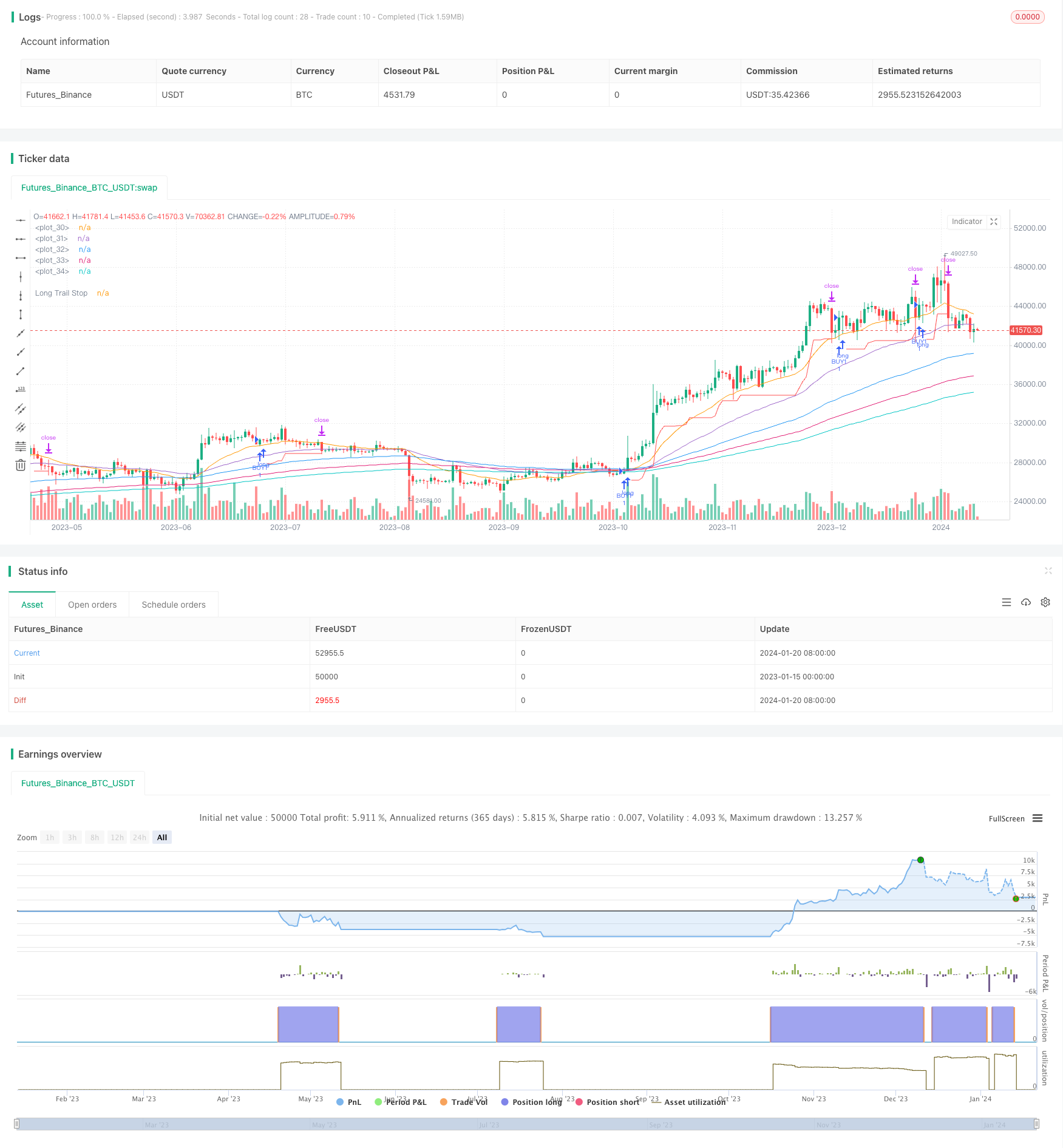
概述
多重均线多头趋势策略是一个基于多条不同周期的指数移动平均线(EMA)构建判断的趋势跟踪策略。它会在价格突破10日EMA并且其他较长周期的EMA线呈多头排列时做多;然后使用8%的尾随止损来锁定利润。
策略原理
该策略使用了10日、20日、50日、100日、150日和200日六条不同周期的EMA线。这些EMA线被用来判断市场目前所处的周期阶段。当短期EMA线(如10日线)上穿较长周期的EMA线(如20日、50日线)时,被视为市场步入多头趋势的markup阶段。
具体来说,当满足以下几个条件时,策略会开仓做多:
- 10日EMA线高于20日EMA线
- 20日EMA线高于50日EMA线
- 100日EMA线高于150日EMA线
- 150日EMA线高于200日EMA线
- 收盘价上穿10日EMA线
做多开仓后,策略会使用8%的尾随止损来锁定利润。也就是说,只要股票价格没有回落超过购买价格的8%,那么就会继续持有该头寸。一旦出现超过8%的回撤,就会停止损失。
总的来说,该策略的核心思路是:使用EMA多重筛选条件判断进入多头趋势后,尾随止损来锁定利润。
优势分析
这种多重均线多头趋势策略具有以下几点主要优势:
- 可以有效过滤假突破,确保抓住价格循环的markup阶段,减少不必要的交易次数。
- EMA线的多重过滤可以减少止损被击穿的可能性,可以更安全的持仓。
- 8%的尾随止损 neither too tight nor too loose,既可以很好的锁定利润,也可以避免过于频繁的止损。
- 该策略对参数调优灵活,可以根据不同品种找到最佳参数组合。
风险分析
该策略也存在一些风险需要注意:
- EMA线排列顺序并不能百分之百判断行情趋势,仍存在一定被套的可能。
- 8%的尾随止损在大幅行情中可能会损失一部分利润。
- EMA均线系统本身滞后于价格变化,转折点判定可能会有点滞后。
针对以上风险,我们可以通过适当调整EMA周期参数或者引入其他指标作为辅助判断来进行优化和改进。
优化方向
考虑到该策略的特点,未来可以从以下几个方面进行优化:
- 测试不同的EMA组合和周期参数,找到最优参数。
- 增加volatility index类指标来判断趋势强度,避免不必要开仓。
- 增加更多过滤指标,如MACD, KDJ等判断多头排列。
- 引入机器学习算法,实现动态止损。
总结
多重均线多头趋势策略整体来说是一个较为稳健可靠的趋势跟踪策略。它同时兼顾了趋势判断和风险控制。通过参数调优和算法优化还具有很大的改进空间。总的来说这是一个值得尝试使用和研究的有效策略。
策略源码
/*backtest
start: 2023-01-15 00:00:00
end: 2024-01-21 00:00:00
period: 1d
basePeriod: 1h
exchanges: [{"eid":"Futures_Binance","currency":"BTC_USDT"}]
*/
//@version=5
strategy('SirSeff\'s EMA Rainbow', overlay=true)
// Testing Start dates
testStartYear = input(2000, 'Backtest Start Year')
testStartMonth = input(1, 'Backtest Start Month')
testStartDay = input(1, 'Backtest Start Day')
testPeriodStart = timestamp(testStartYear, testStartMonth, testStartDay, 0, 0)
//Stop date if you want to use a specific range of dates
testStopYear = input(2100, 'Backtest Stop Year')
testStopMonth = input(12, 'Backtest Stop Month')
testStopDay = input(30, 'Backtest Stop Day')
testPeriodStop = timestamp(testStopYear, testStopMonth, testStopDay, 0, 0)
testPeriod() =>
time >= testPeriodStart and time <= testPeriodStop ? true : false
// Component Code Stop
//TSP
trailStop = input.float(title='Long Trailing Stop (%)', minval=0.0, step=0.1, defval=8) * 0.01
longStopPrice = 0.0
longStopPrice := if strategy.position_size > 0
stopValue = close * (1 - trailStop)
math.max(stopValue, longStopPrice[1])
else
0
//PLOTS
plot(series=strategy.position_size > 0 ? longStopPrice : na, color=color.new(color.red, 0), style=plot.style_linebr, linewidth=1, title='Long Trail Stop', offset=1, title='Long Trail Stop')
plot(ta.ema(close, 20))
plot(ta.ema(close, 50))
plot(ta.ema(close, 100))
plot(ta.ema(close, 150))
plot(ta.ema(close, 200))
//OPEN
longCondition = ta.ema(close, 10) > ta.ema(close, 20) and ta.ema(close, 20) > ta.ema(close, 50) and ta.ema(close, 100) > ta.ema(close, 150) and ta.ema(close, 150) > ta.ema(close, 200)
if longCondition and ta.crossover(close,ta.ema(close,10)) and testPeriod()
strategy.entry("BUY1", strategy.long)
if longCondition and ta.crossover(ta.ema(close,10),ta.ema(close,20)) and testPeriod()
strategy.entry("BUY2'", strategy.long)
//CLOSE @ TSL
if strategy.position_size > 0 and testPeriod()
strategy.exit(id='TSP', stop=longStopPrice)